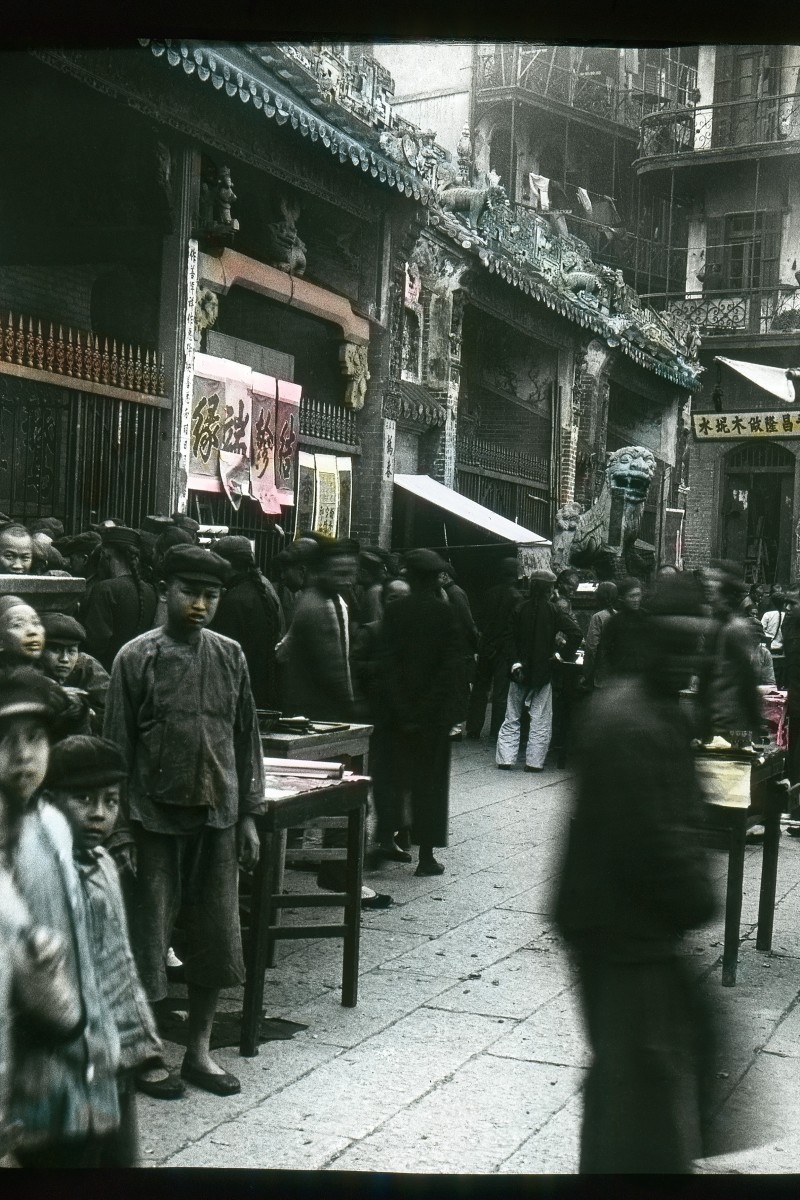
Antique photographs from Hungarian Dezs Bozoky bring Hong Kong history to life
What were Hong Kong’s colonial days like? Junior reporters got a glimpse of our city’s past, captured in masterpieces by a Hungarian photographer
 Dezso Bozoky photographed Hong Kong in 1907.
Dezso Bozoky photographed Hong Kong in 1907.It is hard to imagine what Hong Kong was like during colonial days. But photos from Hungarian Photographer Dezső Bozoky show the beauty and chaos of our city’s past. The University Museum and Art Gallery (UMag) at the University of Hong Kong (HKU) is currently showing some of the photographer’s classic works in the exhibit “Pictures of the Past: Hungarian Photographer Dezső Bozoky in Hong Kong”.
The hand painted glass photos of Hong Kong look stunning against the red backdrop, but it’s the history of these photographs that makes them so meaningful. Dr Florian Knothe, director of UMag, helped us delve deep into the stories behind each photo of the exhibition, taking us back in time to the era of colonial Hong Kong.
The images were captured by Hungarian Photographer Dezs Bozoky, who worked as a doctor on an Austro-Hungarian navy ship to East Asia in 1907. During his two-year adventure in Asia, Bozoky took more than 1,500 photographs, 58 of them in Hong Kong.
“Back then, there weren’t many professional photographers, and there were very few photographs of landscapes,” says Knothe. “The majority were just portrait shots.” This is what makes these photos so precious today, especially for the younger generation who were born after the handover.
And although Bozoky’s occupation was entirely unrelated to photography, the composition of his photos and how he used fundamental techniques – such as motion blur to capture the busy street life – would give today’s Instagram stars a run for their money.
Even though Bozoky was the man behind the camera, this exhibition is the hard work of many people. The photos were first developed onto tiny 8cm by 8cm glass panels. Then painters from around the world hand-painted parts of the panel, each bringing a touch of life to the images. Finally, a team from HKU enlarged the photos to their maximum size, and for the first time ever Hongkongers are able to see them in person.
Besides giving us a rare glimpse into the colonial architecture and street life, these photos also show that Hong Kong has been a melting pot of Western and Oriental culture for centuries. One photo in particular illustrates this concept: it is “split” right down the middle, with a European-style building on the left and a Chinese attic on the right.
In spite of how much the skyline of Hong Kong has changed over the years, it’s great to see the city’s before all the reclamation works and the jaw-dropping skyscrapers. And while its physical appearance has evolved, the cultures that are mixing to make this city so great are still alive and well.
Veronica Lin
Dr Dezs Bozoky’s tour of Asia coincided with the end of the Qing dynasty and the first years of British rule, and these images represent the era perfectly. As not many photos from that time still exist, Bozoky’s journal and photos are a highly valued source of information on the city’s history and culture.
Bozoky recalled that “the smell of camphor mixed with cinnamon” was among his first impressions of Hong Kong. As a European doctor who likely had multiple assistants to carry around his camera, Bozoky likely drew local children’s curiosity without much effort.
His pictures show street scenes of Chinese people going about their daily business, most of them dressed in simple tangzhuangs. Artists have hand-painted the photos to bring vivid detail to the scenes of daily life in Hong Kong.
Dr Knothe explained the complicated process in taking and developing the photographs, especially considering the limitations of technology at the time. The composition, point of view, and artistic flourishes, create images that are intimate.
Due to the extensive development of Hong Kong in the following century, the exact location of some of the photos remains uncertain. Several of them were taken in places where Hong Kong’s most iconic buildings stand today. Our city has revolutionised itself in the years since Bozoky’s visit, but although the Hong Kong of this time is almost unrecognisable, these photos capture an important bustling atmosphere, stunningly lifelike even a hundred years later. One can imagine the sounds of the crowd in action, drawing from our own collective memories of this city.
What kind of moments will survive to become the images by which our descendants view us? It’s a question worth thinking about. Knothe says he hopes that Bozoky’s photos will inspire Hongkongers to pay more attention to the beautiful moments in our own lives.
Sarah Niu
This collection of paintings and photos by Hungarian doctor and artist Dezs Bozoky show Hong Kong in the 1900s, an age forgotten by most of the world. Many photos show what life was like back in colonial Hong Kong. Most Hongkongers don’t know about this because the city no longer has many colonial-era style, aka European style, buildings.
Bozoky, a brave Hungarian doctor and photographer, took some of the first photos of Colonial Hong Kong. Since they are over a 100 years old it is a miracle that they survived in good condition.
Bozoky most likely took these just to see the daily life of the locals in the City of Victoria, as Hong Kong was called by the British. He was interested in the behaviour of people and how they interacted. He photographed rich Westerners of the Peak and the Chinese of what is now Sai Ying Pun. He also kept a diary about his travels, and wrote a lot of Hong Kong.
Timothy Tang